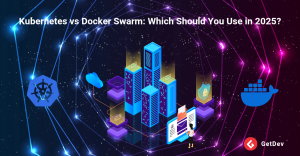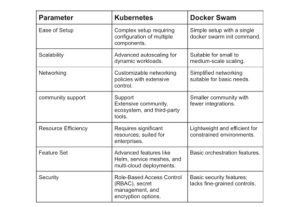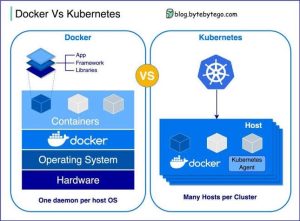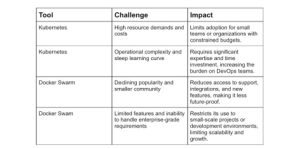
The world of container orchestration is evolving rapidly, and in 2025, two tools remain at the forefront: Kubernetes and Docker Swarm. Both serve the purpose of managing and scaling containerized applications, yet their differences in complexity, features, and use cases often spark debates among developers and organizations alike.
This article explores Kubernetes and Docker Swarm in depth, comparing their capabilities, strengths, and weaknesses. By the end, you’ll have a clear understanding of which tool best suits your needs in 2025.
Introduction to Kubernetes
Kubernetes (K8s) is an open-source container orchestration platform initially developed by Google. It is built to manage large-scale applications with multiple microservices. Kubernetes automates critical tasks such as deployment, scaling, and management of containers, making it a powerful solution for complex workloads.
Key Features of Kubernetes:
- Autoscaling: Automatically adjusts workloads to handle fluctuating traffic or compute needs.
- Self-Healing: Automatically restarts failed containers and replaces unhealthy nodes.
- Multi-Cloud Support: Seamlessly works across on-premises and cloud environments.
- Load Balancing: Distributes traffic intelligently to maintain performance.
- Declarative Configuration: Manage applications via YAML/JSON, ensuring consistency.
Real-World Use Case:
An e-commerce giant like Amazon uses Kubernetes to handle millions of users across the globe, ensuring seamless scaling during Black Friday or other high-traffic events.
Introduction to Docker Swarm
Docker Swarm is Docker’s native container orchestration tool. It transforms a group of Docker engines into a single virtual cluster for managing containers. Unlike Kubernetes, Docker Swarm is known for its simplicity and ease of use, making it an ideal choice for smaller teams or projects with limited complexity.
Key Features of Docker Swarm:
- Native Docker Integration: Works seamlessly with Docker CLI and existing tools.
- Quick Setup: Requires minimal effort to deploy and manage clusters.
- Built-In Load Balancing: Automatically routes requests between containerized services.
- Lightweight Architecture: Uses fewer resources compared to Kubernetes.
- Ease of Maintenance: Simpler to troubleshoot and operate.
Side-by-Side Comparison
The table below provides a detailed comparison between Kubernetes and Docker Swarm:

Detailed Comparison
1. Ease of Setup and Learning Curve
- Kubernetes: Setting up Kubernetes can be daunting due to its steep learning curve and numerous components such as Pods, Deployments, and Services. Managed services like AWS EKS and Google GKE can ease this process.
- Docker Swarm: With just a single command (docker swarm init), you can create a cluster. Its simplicity makes it beginner-friendly, especially for developers already familiar with Docker.
Winner: Docker Swarm (for simplicity).
2. Scalability and Performance
- Kubernetes: Built to handle massive workloads with features like horizontal pod autoscaling and cluster autoscaling. Perfect for dynamic environments where traffic fluctuates.
- Docker Swarm: While it supports scaling, it struggles to handle highly dynamic workloads efficiently.
Winner: Kubernetes (for large-scale, complex applications).
3. Features and Functionality
- Kubernetes: Offers rolling updates, canary deployments, and self-healing capabilities. It integrates seamlessly with CI/CD pipelines.
- Docker Swarm: Provides basic orchestration features, but lacks the advanced capabilities of Kubernetes.
Winner: Kubernetes (for feature depth).
4. Security
- Kubernetes: Implements Role-Based Access Control (RBAC), secret management, and pod security policies.
- Docker Swarm: Security is basic and lacks Kubernetes’ granular controls.
Winner: Kubernetes (for enterprise-grade security).
5. Networking
- Kubernetes: Allows highly customizable networking with support for service meshes like Istio or Linkerd.
- Docker Swarm: Features built-in service discovery and routing but lacks advanced networking features.
Winner: Kubernetes (for advanced networking needs).

Visual Comparison
Below is a visual representation to summarize the differences:

Challenges in 2025
As container orchestration tools mature, they also face a unique set of challenges. Both Kubernetes and Docker Swarm encounter limitations that users need to consider before adopting them. Here’s an in-depth look at their respective challenges in 2025:
Kubernetes Challenges
1. Resource Demands
Kubernetes is inherently resource-intensive, often requiring significant hardware and memory to function optimally. Its master nodes, which handle tasks like scheduling, maintaining cluster states, and storing configuration data, consume substantial resources. For example:
- CPU and Memory Usage: Even a small Kubernetes cluster can demand several gigabytes of memory and powerful processors, making it difficult for small teams or budget-conscious organizations to adopt.
- Cost Implications: The resource-intensive nature means higher costs, especially for organizations running Kubernetes clusters in the cloud. Scaling up adds to expenses, as more nodes and compute power are required to handle large workloads.
This limitation makes Kubernetes less appealing for startups, small-scale projects, or environments with constrained infrastructure.
2. Operational Complexity
Kubernetes’ advanced capabilities come at the cost of operational complexity. Managing a Kubernetes cluster involves several moving parts, such as:
- Cluster Management: Administrators need to, monitor, and maintain various components, including pods, nodes, namespaces, and ingress controllers. The interconnected nature of these components increases the risk of misconfigurations.
- Learning Curve: Teams must be proficient in Kubernetes concepts like YAML configurations, role-based access control (RBAC), and advanced networking policies.
- Maintenance Overhead: Regular updates, patching, and debugging of Kubernetes components are time-intensive tasks. For example, upgrading a cluster to a new Kubernetes version often requires meticulous planning to avoid downtime or compatibility issues.
Organizations without a dedicated DevOps team may struggle to efficiently manage Kubernetes, leading to operational bottlenecks.
Docker Swarm Challenges
1. Declining Popularity
Docker Swarm has seen a decline in popularity due to Kubernetes’ overwhelming adoption as the industry standard for container orchestration. This decline poses several challenges for Swarm users:
- Smaller Community: While Kubernetes boasts a massive, active community that contributes to its development and provides extensive support, Docker Swarm’s user base is relatively smaller. This results in:
- Fewer tutorials, troubleshooting guides, and open-source integrations.
- A slower pace of innovation, as fewer developers are contributing to its ecosystem.
- Reduced Ecosystem Integrations: Many third-party tools, such as monitoring and logging solutions, are increasingly focused on Kubernetes, leaving Swarm users with fewer options for ecosystem compatibility.
For organizations that prioritize long-term support and access to cutting-edge tools, this declining popularity makes Docker Swarm less viable.
2. Limited Features
Docker Swarm’s simplicity, while an advantage for small-scale projects, becomes a drawback in complex, enterprise-grade environments. Its feature set lags behind Kubernetes in several critical areas:
- Autoscaling Limitations: Unlike Kubernetes, Docker Swarm does not offer advanced autoscaling capabilities based on custom metrics, making it harder to adapt to unpredictable traffic spikes.
- Networking Constraints: Docker Swarm’s networking options are more basic, which may not meet the needs of applications requiring advanced network policies, routing, or multi-cluster communication.
- Stateful Workloads: Swarm struggles with managing persistent storage and stateful workloads, whereas Kubernetes excels with its integrations for storage orchestration.
This lack of advanced functionality makes Docker Swarm unsuitable for enterprises managing large-scale, distributed systems or deploying applications across multiple cloud environments.

Both tools require careful consideration of these challenges to align with your organizational needs and resources. For businesses that value long-term scalability and support, Kubernetes may be worth the complexity. Conversely, for smaller teams that prioritize simplicity, Docker Swarm may still hold value despite its declining ecosystem.
When to Use Each Tool
Choosing between Kubernetes and Docker Swarm depends on the specific requirements of your project, the expertise of your team, and the scale of your application. Below is an in-depth guide to help you decide when each tool is best suited for your needs.
When to Use Kubernetes
1. Managing Large, Complex Applications Requiring Advanced Orchestration
Kubernetes shines in scenarios where applications involve multiple interconnected microservices, complex workflows, or varying workloads. For instance:
- Enterprise-Grade Systems: Businesses operating in industries like e-commerce, finance, or healthcare often require Kubernetes’ advanced orchestration to manage numerous services, databases, and APIs.
- High Availability: Kubernetes ensures fault tolerance by automatically redistributing workloads when nodes or containers fail, making it indispensable for mission-critical systems.
- Dynamic Scaling: Kubernetes’ ability to handle traffic spikes and resource demands makes it ideal for scenarios like flash sales in retail or large-scale events such as streaming services during major sports tournaments.
Example Use Case:
A global e-commerce platform with millions of daily active users can use Kubernetes to orchestrate services such as user authentication, payment processing, and product recommendations, ensuring each service scales independently based on demand.
2. Your Team Is Experienced and Capable of Handling Kubernetes’ Complexity
Kubernetes requires a team with a strong understanding of its architecture and operations. This includes knowledge of:
- Configuration Management: Writing and managing YAML manifests to define resources like deployments, services, and pods.
- Networking: Configuring ingress controllers, service meshes, and network policies for secure communication.
- Monitoring and Logging: Using tools like Prometheus, Grafana, or ELK stack to ensure observability and troubleshoot issues.
Without proper expertise, the complexity of Kubernetes can lead to inefficiencies, misconfigurations, and wasted resources.
Ideal Teams:
- Large Organizations with Dedicated DevOps Teams: Kubernetes suits teams that can invest in ongoing learning and support.
- Companies Running Complex CI/CD Pipelines: Teams with experience in automating deployments will find Kubernetes indispensable for improving delivery speed and reliability.
3. Scaling Applications Globally or Integrating Multi-Cloud Environments: Kubernetes excels in orchestrating workloads across diverse infrastructures, making it the go-to choice for global deployments and hybrid or multi-cloud strategies. Its robust features include:
- Multi-Cloud Orchestration: Kubernetes allows seamless deployment across cloud providers like AWS, Azure, and Google Cloud, enabling organizations to avoid vendor lock-in and optimize costs.
- Edge Computing Support: Lightweight Kubernetes distributions like K3s are tailored for deploying applications at the edge, such as IoT devices or regional data centers.
Example Use Case:
A video streaming service leveraging AWS for North America and GCP for Europe can use Kubernetes to maintain consistent deployments and ensure optimal performance for users in different regions.
When to Use Docker Swarm
1. Working on Small to Medium-Sized Projects: Docker Swarm’s simplicity makes it an excellent choice for projects that don’t require the advanced capabilities of Kubernetes. Examples include:
- Startups and Small Teams: For teams with limited resources, Docker Swarm enables quick deployment and easy management of containerized applications.
- Prototypes and MVPs (Minimum Viable Products): Swarm’s lightweight architecture allows developers to focus on building and iterating on their applications without getting bogged down by complex configurations.
Example Use Case:
A startup developing a food delivery app with a small user base can use Docker Swarm to orchestrate services like order management, real-time tracking, and notifications without overcomplicating their infrastructure.
2. Speed and Simplicity Are Your Top Priorities: Docker Swarm is built into Docker, meaning developers already familiar with Docker can leverage Swarm with minimal effort. Its key advantages include:
- Rapid Setup: A Swarm cluster can be created with a single command (docker swarm init), enabling teams to deploy applications quickly.
- Ease of Use: The unified Docker CLI provides a consistent experience, allowing developers to manage containers, networks, and services seamlessly.
- Lightweight Footprint: With fewer components than Kubernetes, Swarm consumes fewer resources, making it ideal for environments with limited hardware.
Ideal Teams:
- Development Teams Focused on Fast Iterations: Swarm simplifies testing and deployment during the development phase.
- Organizations with Limited Technical Expertise: Teams without dedicated DevOps engineers can still manage containers effectively using Docker Swarm.
3. Your Team Is Already Familiar with Docker: Since Docker Swarm integrates directly with Docker, it eliminates the need for developers to learn a new orchestration platform. Teams that are comfortable with Docker Compose, Dockerfiles, and the Docker CLI will find Swarm’s workflow intuitive and straightforward.
Example Use Case:
A SaaS company building internal tools for HR management can use Docker Swarm to deploy their application with minimal training for their team, leveraging their existing Docker expertise.
Conclusion: Kubernetes or Docker Swarm?
In 2025, Kubernetes has firmly established itself as the leading solution for enterprise-scale container orchestration. Its powerful features, such as automated scaling, self-healing, and seamless multi-cloud integration, make it the preferred choice for developers managing complex and dynamic workloads. With a vast and continually growing ecosystem of tools, plugins, and community support, Kubernetes offers unparalleled flexibility for organizations looking to build and maintain resilient infrastructures. It has become the backbone of modern microservices architecture, enabling businesses to handle millions of transactions, ensure fault tolerance, and optimize resource utilization at scale.
However, Docker Swarm continues to hold value, especially for teams that prioritize simplicity, rapid deployment, and cost-effective solutions. As a lightweight alternative, Docker Swarm eliminates much of the operational overhead associated with Kubernetes, making it an excellent option for small to medium-sized projects, prototypes, and startups with limited technical expertise. By leveraging Docker’s unified CLI and straightforward setup, Swarm allows developers to focus more on building applications and less on managing orchestration complexities.
The ultimate decision between Kubernetes and Docker Swarm lies in evaluating the specific needs of your project, the expertise of your team, and your organization’s long-term scalability goals. Kubernetes is ideal for enterprises aiming for global reach, advanced orchestration, and robust infrastructure, while Docker Swarm caters to teams seeking a simpler, faster, and more accessible entry point to container orchestration.
Regardless of which tool you choose, the primary focus should always remain on building resilient, scalable, and efficient systems that provide seamless experiences for your users. Both Kubernetes and Docker Swarm are capable of supporting high-performance applications when used in the right context. Take the time to understand your requirements and align your choice with your project’s unique demands.
Remember, the tool is only as effective as the strategy behind it. Choose wisely, invest in upskilling your team, and embrace container orchestration as a powerful enabler of innovation and efficiency in 2025. Happy orchestrating!